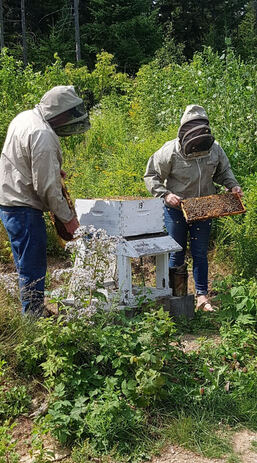True or false? One out of every three mouthfuls of food we eat comes to us with the help of bees.
False, but if you change the word ‘bees’ to ‘pollinators,’ it would be true, and bees are one of Canada’s most important pollinators.
Squash, cucumbers, blueberries, apples, cashews, sunflowers, alfalfa and clover are some of the many plants we eat, either directly or by eating meat. All of these rely, to varying degrees, on the presence of pollinators.
Bees are declining throughout the world both in the wild and in human-made hives. They need our care and support, and so do our beekeepers.

Peeking inside a beehive
Bees are fascinating and fun. I first became a passionate bee-watcher when my brother started up a few hives on his New Zealand farm just before I came to visit. Staying on my brother's farm is usually more work than play, but we found ourselves hanging over the gate by the beehives several times a day just watching the bees coming and going in their search for pollen. Sometimes we could even see the little yellow pollen sacks attached to their legs. Of course, the flowering shrubs in the area were buzzing, especially on a sunny day. Looking inside a hive was the biggest treat even though it meant suiting up. And the honey was all the sweeter because it came from “our” bees.
I missed the bees (and the honey) when I returned to Canada so I was delighted when Donnie Porter dipped his toe into the world of bees just up the road in Riverside-Albert. Now he is a commercial beekeeper, which means he has more than 50 hives, and his thriving business includes nucs, honey, blueberry pollination and beeswax candles.
No idea what a nuc is? I had to ask Donnie myself and discovered that it is a beekeeping starter kit complete with eggs, pollen, a frame of honey and the all-important queen bee. To have your own functioning hive, you can get a hive kit from a bee store such as Clarence Farm Services in Moncton. You must also register your hives with the provincial government.
For new beekeepers, lots of encouragement and advice comes along with bees and equipment. “Most beekeepers are very supportive of beginners,” Donnie says. He credits the support of a great mentor and local beekeeping courses for his own successful beekeeping beginnings.
Mites and sites
A beekeeper’s year is full of challenges and surprises. The first task is to pick a warm spring day and remove the protective wrap from the hives. It's always a tremendous thrill to see a throbbing mass of bees. Not all hives survive the winter, especially if it has been abnormally long and cold.
The next task is to give each hive pollen and sugar to tide the bees over until there are enough blossoms to provide them with food. It's also very important to make sure the queen is one of the survivors. A hive without a queen is in serious trouble because only the queens can produce eggs.
In early June the hives are taken out to sites where there are lots of plants needing to be pollinated, such as commercial blueberry or cranberry fields and apple orchards. The bees are “on pollination” until the blossoms finish, usually around the end of June, then they are brought home to their summer quarters where a mite count is done. Bee mites can destroy a colony of honey bees if not controlled. Depending on the level of infestation, the beekeeper must decide on treatment for the affected hives. If necessary, other threats to the health of the colony are treated at this time. Summer quarters or “bee yards” should be close to people for protection, but not near other commercial hives to avoid competition for food and the spread of disease.
Removal of honey from the hives takes place in late summer. By mid-September, a beekeeper will be thinking about preparing the hives for winter. “Having your bees well fed and finding them quiet, protected winter quarters is very important.” Donnie says “Then you need to keep your fingers crossed and hope that everything turns out right.”
Befriending Bees
I asked Donnie how we could support the health of bees in our neighbourhoods. Here are some of his suggestions: Stop or reduce spraying toxic substances in our gardens and lawns Grow or buy organic fruits, grains and vegetables Plant wildflowers As amateur or commercial beekeepers, use the least harmful treatments for the bees and place hives where they will be safe from predators and human disturbances.
Unbelievable bee facts
In its lifetime, each Canadian honey bee makes about one tenth of a teaspoon of honey. Every day a bee makes around ten trips to visit more than 10,000 flowers. Worker bees actually wear out their wings finding food.
Great sites for bee information
The University of Guelph has YouTube beekeeping videos and Vermont's Micheal Palmer has YouTube videos about beekeeping which are relevant to our area. Also, the NB Beekeepers Association has useful information and a mentorship program for amateur beekeepers. The Canadian Honey Council has information but mostly for large commercial beekeepers.
Sources of local honey:
- Robert Seamans’ honey is sold at his roadside stand in Parkindale and the Sussex Market.
- Jerry Harper’s honey is sold at Harpers U-Pick Raspberries (Hillsborough).
- Erin Carver’s Cedar House Honey is sold at The Old Church Farmers’ Market in Hillsborough.
- Donnie Porter’s honey is available at Crooked Creek Convenience, Waterside Winery, and from his house in Riverside-Albert.
- Terry Steeves sells honey in Elgin.
- Facebook’s Marketplace often has listings for local honey.
 RSS Feed
RSS Feed